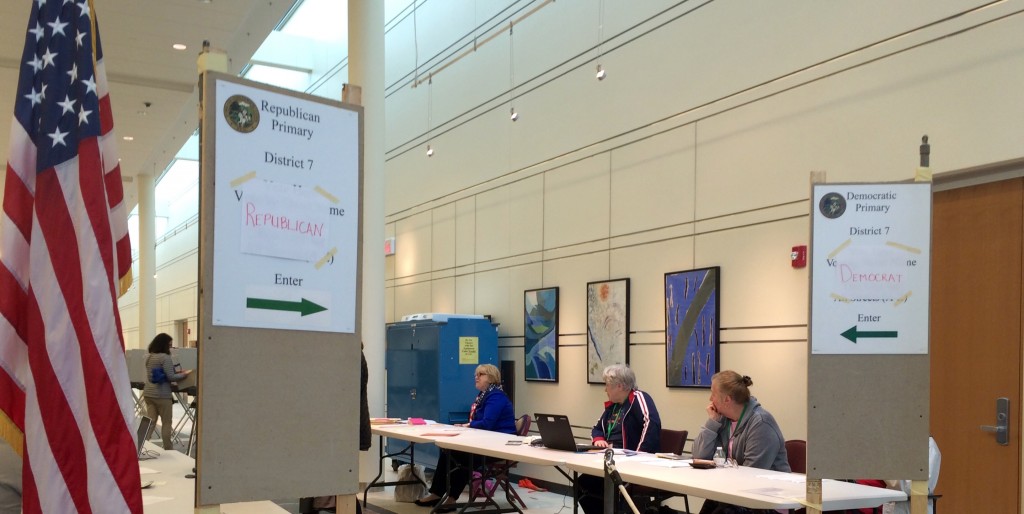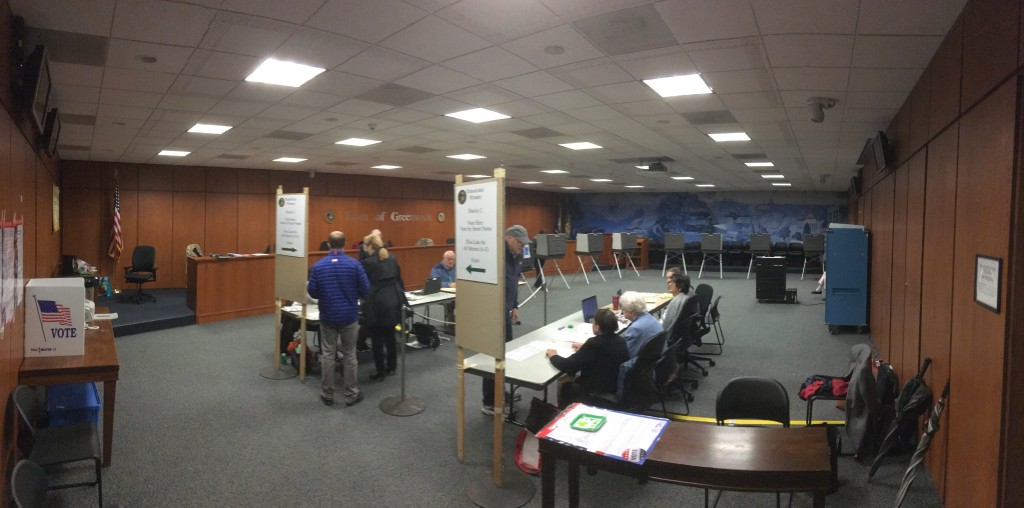

Voters are the bedrock of a democracy. But the security of the vote is increasingly raising political questions; what some call checks and balances on possible election fraud others call schematic suppression of targeted voters.
In a panel discussion presented by the Greenwich League of Women Voters, the debate continued before a packed crowd in the Cole Auditorium at the Greenwich Library on Tuesday.
Victoria Bassetti, a fellow at New York University School of Law’s Brennan Center for Justice, moderated a panel featuring Denise Merrill, Connecticut’s Secretary of State; Michael Brandi, executive director of the State Elections Enforcement Commission; John Fund, national affairs columnist for the National Review; and Michael Waldman, president of the Brennan Center and a constitutional lawyer.
“Connecticut has a better than average record at these issues,” said Fund, a former member of the Wall Street Journal’s editorial board. “But you have had your problems. Just last year, one of your former colleagues, Christina Ayala, was convicted of voter fraud.”
Ayala, a former state representative from Bridgeport, plead guilty to two counts of providing false information after giving authorities fabricated evidence of her home address. State and local election laws were said to have been broken and a plea deal shortened her sentence to a year in jail and banned her from running for office for two years. 
However, just like the upcoming presidential debates themselves, sides were taken center stage on the issue of the risk, or non-risk, of fraud being committed at the polls and elsewhere.
“I think the risk of in-person voter fraud is basically non-existent,” said Brandi. “I will say there are other areas of fraud that do exist, and that’s where our commission in particular has to remain vigilant.”
Brandi also said the press was “instrumental” to the local case that Fund cited.
“It was the press that picked up that the address she was reporting to the court was not the address where she allegedly lived,” said Brandi.
Fund argued that in-person voter fraud is prevalent, citing an experiment done by the New York City Department of Investigation (DOI) during the 2013 Mayoral race.
“They decided to have a test of the Board of Elections in New York City,” said Fund. “They sent out investigators to vote in the names of 63 people at the polls. These were people who were either dead, moved out of state or were sitting in jail.”
Of the 63 tries, 61 were successful. The only two that failed, according to Fund, was one investigator that was told they were at the wrong polling place, while a poll worker at another site stopped another investigator from voting in her incarcerated son’s name after noticing the error.
“This includes a 21-year-old Puerto Rican investigator trying to vote in the name of a 87-year-old Polish immigrant,” said Fund. “How do you know how much in-person fraud there is if it’s the perfect crime and if you can only find out if someone confesses? Voter ID is a simple, practical way to try and curb a problem that could be larger than we think.”
Fund’s comments were met with applause from the crowd of over 100, but Waldman rebutted his argument with recent data that shows the rarity of supposed voter fraud.
According to the Walter Cronkite School at Arizona State University, of 2,068 alleged election-fraud cases, 10 cases were found to be confirmed prosecutions of voter impersonation, the only kind of fraud that can be prevented by voter ID at the polls.
The Washington Post also reported that out of a billion ballots cast in general, primary and municipal elections since 2000, only 31 of voting fraud were reported (those reports may have included cases that were prosecuted and others that were debunked).
“These are actual facts,” said Waldman of the Brennan Center for Justice. “Do you remember the day you read in the newspaper about the time those elections were stolen because of the big conspiracy of in-person voter impersonation? No, because it didn’t happen.”

Waldman added that, while he was in favor of voter ID, he is against requiring forms of ID that people do not have.
“I think the system in Connecticut is good, and there are plenty of systems that require forms of ID that work perfectly well,” said Waldman.
Waldman also accused Fund of circulating an article that said the LWV was a left-wing funded pressure group—something that Fund called a “personal attack” and a “cheap shot.”
“This is not the way to treat our democracy,” said Waldman. “This is not the way to treat the voters of our democracy.”
Liberals argue that these voter ID laws disenfranchise minorities and also seniors who have to tackle hurdles of identification, transportation and more come election season.
While a driver’s license isn’t the only acceptable form of ID, minorities may face added challenges in obtaining valid ID. Not only are minorities less likely to have a driver’s license due to socio-economical circumstances, but trying to retrieve the correct documents to solve the issue can create other problems, such as a perceived voting tax.
In some cases, more identification is required to obtain a photo ID like a driver’s license than to cast your ballot at your poll location. While the necessary forms of ID to vote vary from state to state, the crux of the issue is that those specific ID applications often ask for more documentation than a voter would need to register and vote, making for catch-22 scenarios that bedevil a higher percentage of minority voters.
The Brennan Center has found that in 10 states with unprecedentedly restrictive voter ID laws, obtaining a free photo ID can be a challenge to those without transportation to these designated government offices. It found that 1.2 million eligible black voters and 500,000 eligible Hispanic voters live more than 10 miles from their nearest ID-issuing office open more than two days a week.
State Secretary Denise Merrill suggested that Connecticut has one of the best voter ID laws in the country: “It is not discriminatory.”
“It is not that we ask for photo ID’s,” Merrill added. “We do. The key difference is that we also allow other forms of ID on the registration list. I think the way to get around this very terrible debate is to tackle the real issue of policy to do the best we can do avoid fraud or even the appearance of it. Connecticut’s laws are a good model.”
Several local elected officials were in attendance for the occasionally heated discussion as possible solutions (including putting a photo on Social Security cards, or introducing a national photo ID) were exchanged in an audience Q&A.
In a recent Sentinel column, state Rep. Livvy Floren proposed a locally issued photo ID card without charge to the requestor, with all costs assumed by the Citizens Election Program fund.
The League of Women Voters will also host candidate debates on Thursday, Oct. 13 at Town Hall for candidates for the 151st Assembly District, incumbent Fred Camillo and challenger Dita Bhargava, and for the 36th Senate District between incumbent Scott Frantz and challenger John Blankley.




